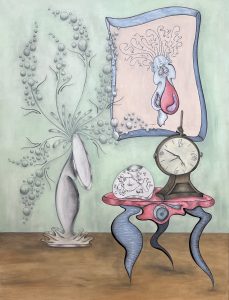Master communication through nonverbal coding
The guy in the header photo is my dad. He was a master at expressing emotion with a glance. Here, you see his “angry” stare. I had him pose for several of these facial expression photos for my book, No Words. He was a great model.
But most of us are not so great when it comes to nonverbal communication.
I’ve written a few articles about communication. In the first article I published here on Medium, I introduced you to communication. Then, I listed the rules of communication. I also told you all about noise. But, we have yet to discuss the codes used in communication: verbal and nonverbal coding.
While I could write for a year about verbal coding, I suspect you spent years learning how to spell, how to craft cogent sentences in accordance with grammar rules, and how to increase your vocabulary. Perhaps I’ll add a few pointers in a future article. But, frankly, language professors have verbal coding covered.
My briar patch is nonverbal coding. I find the symbolic nature of nonverbal communication fascinating — so I’d like to share some of that information with you. As schools ignore the study of nonverbal communication, while focusing on spelling, vocabulary, and writing, you may not have any training in nonverbal communication. And that oversight is criminal.
Communication theorists estimate 60–90% of any communication is nonverbal, although the higher estimations remain a topic of investigation. You will need to explore it for yourself! Even if NVC is only 60% of every communication message, understanding it is vital to communication competence.
How do you read others’ NVC? And how do you encode your NVC so you are understood?
Nonverbal Basics
NVC is all intentional and unintentional messages that are unwritten, unspoken, and not sounded. Most of us think it’s facial expressions, gestures, and other body movements (body language). But that class of NVC — kinesthetic — is only a small part of NVC. Here is a complete list of the discrete categories:
Kinesics–body movement (including posture, orientation, gestures and facial expressions)
Haptics–touch and touching behaviors
Physical appearance
Proxemics–the use of physical space
Environment–the arrangement of time and space
Paralanguage–the nonverbal elements of speech (pause, pitch…).
So, everything you “say” includes the words you use and each of these forms of NVC. And you’ve been so focused on choosing the right word when you should have been paying attention to how you tilted your head or how your voice was changing pitches!
Just like verbal coding, NVC has rules. We know that decoding NVC is a vital skill. And people who decode NVC correctly are considered more attractive to others. They also are highly persuasive, more successful, and have notable emotional intelligence. And they’re popular!
NVC is unavoidable. Even silence communicates!
However, NVC is limited. Try to explain complex physics or politics using only NVC. We need words at this point in our evolution. And, while NVC communicates emotion, recognize that NVC is just as ambiguous as words can be. Even more so. Your friend may say “I’m okay,” but frown. Or shake or sweat. Or wince. So, is the friend okay or not? Which is another reason to learn to craft your nonverbal communication just like you choose the words to say.
We know NVC originated as pre-language: what we did before we had words and writing. Darwin suggested this idea inThe Expression of Emotions in Man and Animals. We said we were hungry or angry with gestures and body position. We ask for help with gestures.
Yet, NVC is not universal. True, six facial expressions — happiness, fear, anger, surprise, disgust, and sadness — are universal. No matter where you are in the world, the people there will express those emotions with identifiable facial coding. Gestures, posture, physical distance, and so on, change with culture. Important to consider when traveling!

Some interesting theories:
Disgust, depicted above, has a biological connection. When we smell something unpleasant, something disgusting, that facial expression closes off the nasal passages. So, when we hear or read something disgusting, we make that face!
A headshake to indicate “no” may be related to an infant being satiated when breastfeeding. The baby will pull away and turn his or her head back and forth.
When a person is truly interested in another person or a topic, his or her pupils will dilate. It can’t be helped (it’s an automatic physical reaction — like blushing, sweating, or shaking).
NVC may have biological or sociological purposes aside from language. For example, NVC may play a part in altering our emotional state. It’s a chicken-egg argument. We’ve believed we shed tears and slump over when sad — but the tears and posture may cause the emotion.
NVC is not more reliable and does not communicate more meaning that words. It can compliment what is said. Or contradict the words. We also should not rely on NVC to read another’s mind. Yes, some people are better at reading NVC and are slightly better than average at identifying a lie. In most cases, NVC is too ambiguous to help us know what another person is thinking.
However, if you know another person well, you can notice changes in that person’s normal rate or pitch of speech, or body movements, to know that something is “off.” Knowing is more than half the battle! Similarly, people who work in investigatory industries, like police officers or TSA agents, become adept at noticing odd NVC behavior.
PUPPIES AND KITTIES
I intend to add to this series with in-depth articles about each type of NVC. It’s fascinating stuff. But for this episode, I would like you to get comfortable observing NVC. And puppies and kitties make the best lab partners!
Consider your dog (if you have one), or interactions you have had with dogs. You smile and use a lilting, cheerful tone, to say to the dog: “I hate you. I want to lock you in a crate. You are a bad dog!” The dog wags his tail or wiggles his whole body. He scampers about, perhaps bending into a play gesture. The dog, no matter your words, only hears your happy tone and sees your smile. A dog does not understand the meaning of the verbal code: hate, lock you in a crate, bad.
Yes, I know dogs have vocabularies. With an apology to animal lovers (including me), dogs do not understand the complexity and symbolic nature of language. Sure, an average dog can identify about 160 words, but the dog does not understand the words’ meaning. He recognizes the sound combination of those letters–the T-R-T sound in treat, for example. But you cannot ask your dog to define a word for you–or ask your dog for a synonym. Or have a conversation about time travel. Not going to happen.
Let’s say you take an angry tone and you frown, set your jaw, and yell at your dog, “I love you!!! You are the best dog I have ever had!” Your dog will cower. She will run and hide, pull her tail between her legs. The dog only decodes your tone and your facial expression. The dog decodes you are angry. Words mean nothing to a dog. What is love? What is the best?
Have you discussed general relativity or the state of the economy with your cat? Probably not. Maybe you speak to him or her about your job prospects, but the cat does not know your degree is inapplicable to your career path. Your puppy or kitty is great for recognizing and learning how to control your own NVC.
EXERCISE: Working with your pet or a friend’s pet, try out different gestures, facial expressions, postures and tone of voice to better understand NVC. Journal your observations. Your investigation would be more thorough if you try the same exercise with different animals (being careful, of course, not to threaten a strange dog, cat or tiger!). Take this experience and notice others’ NVC — and your own.



